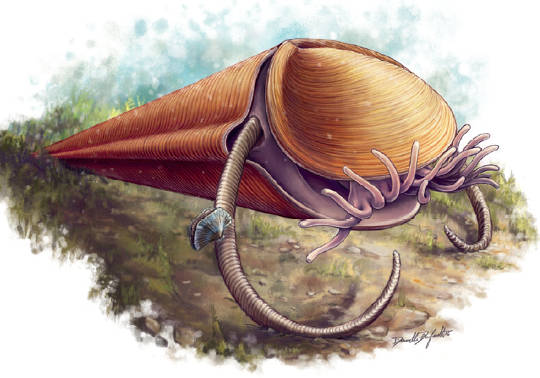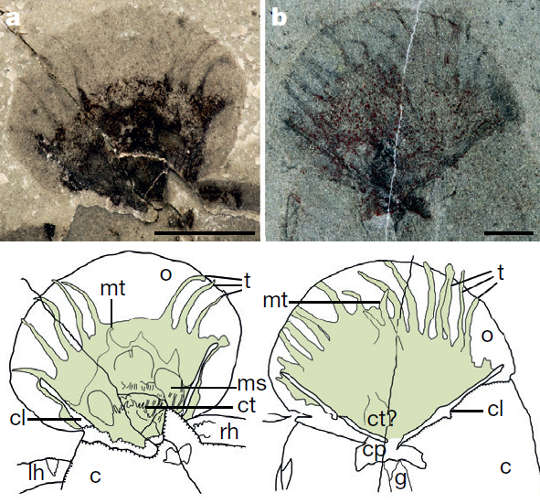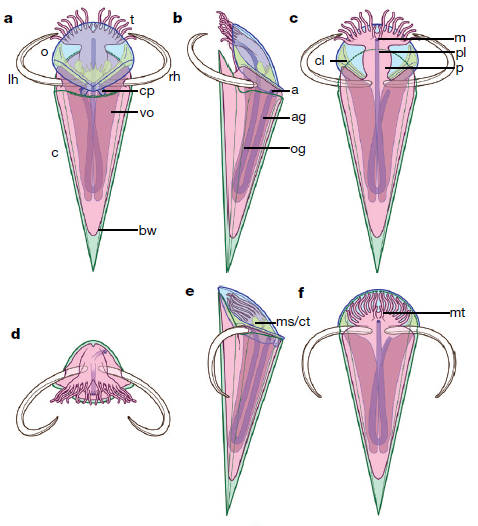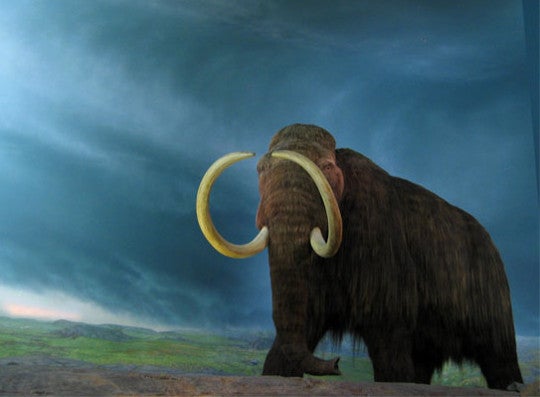This article was published in Scientific American’s former blog network and reflects the views of the author, not necessarily those of Scientific American

Credit: D. Default Royal Ontario Museum, Moysiuk et al. 2017
This ice cream cone sporting woolly mammoth tusks inhabited by the Flying Spaghetti Monster is a creature called Haplophrentis. It actually existed. It made a small splash in Nature last month when scientists studying over 1,500 fossils of this creature made some new discoveries about its anatomy and, consequently, family tree.
Haplophrentis is a type of hyolith, a group of shell-bearing creatures that was abundant during the 280 million years of the Paleozoic but went extinct during the Great Dying before dinosaurs even appeared. For a long time people have wondered exactly what they were and how they fit into Earth's evolutionary tree, because their odd combination of anatomy – a conical shell fitted with a shield-shaped lid and sometimes sporting a pair of spines – doesn’t resemble much else. But scientists didn't have much to go on. Most fossils contained only the hard parts of the creature, and the few traces of soft tissue that did occur commonly were unrevealing.
On supporting science journalism
If you're enjoying this article, consider supporting our award-winning journalism by subscribing. By purchasing a subscription you are helping to ensure the future of impactful stories about the discoveries and ideas shaping our world today.
So a trio of Canadian and British scientists rustled up the 1,500 fossils -- including several new soft-tissue containing specimens from the exciting new Marble Canyon and Stanley Glacier localities of Canada's Burgess Shale -- and, one would imagine, spent a great deal of time peering. Among the new fossils were 254 that preserved traces of the animal’s soft tissue. They saw that the animal had a retractable organ covered in 12-16 tentacles.

Soft tissues found in Haplophrentis fossils. a) lophophore retracted with six tentacles on left side and three on right. b) a retracted lophophore with 16 tentacles. c= conical shell, lh = left helen, rh = right helen, cl= clavicle, cp= cardinal process, ct= connective tissue, g= gut, ms= muscle scar, mt= medial tentacle, o= operculum (lid) pl= pharynx lumen, t = tentacle. Credit: Moysiuk et al. 2017
The organ strongly resembles the feeding apparatus (a lophophore) of a modern group called the lophophorates. Here is what the modern lophophore of a moss animal, or bryozoan, looks like:
Credit: Ar roux Wikimedia (CC BY-SA 4.0)
The tentacles allowed them to conclude that the animal was not closely related to mollusks as has generally been thought, but instead related to a group of lophophorates called brachiopods. Brachiopods are still with us today in deep water and the polar ocean, but 500 million years ago they were even bigger business. The arrangement of the tentacles in adult Haplophrentis is very similar to that found in the larvae of modern brachiopods, but unlike the complex lophophore stylings of brachiopod adults.
The fossils also indicated that the lophophore was retractable, and that the animal had a U-shaped digestive tract. Putting it all together, they came up with a hypothesis for how the creature looked and operated, as you can see in the artist's reconstruction at the top of this page and below. In the images below, a-d show the "Hatch Open" configuration, while e-f show "Business Hours are Over".

Reconstruction drawn with lid open and tentacles extended (a-d) and retracted (e-f). bw= body wall. Credit: Moysiuk et al. 2017
Those tusks -- technically called helens -- are really something else. For the record, here are mammoth tusks, as depicted in a diorama at the Royal British Columbia Museum:

Credit: Rob PongsaJapan Flickr(CC BY 2.0)
Previously, scientists had speculated that Haplophrentis burrowed in the sediment. But in four separate fossils in the new study, smaller brachiopods had glued themselves to the hyolith's helens, as depicted in the reconstruction at the top of this post (go have a look). These same Haplophrentis fossils contained soft tissue traces and the shell parts still seemed firmly attached to one another, making it likely the brachiopods clung to the creature while it was still alive (the creature must have been buried quickly after death for it to be preserved so well).
Today, brachiopods filter food from seawater, so their presence on the helens of a living hyolith indicates that Haplophrentis must have lived on top of the sediment and not within it. The authors speculate that the animal rotated its spiral-shaped tusks to prop itself up off the seabed, perhaps to elevate its feeding tentacles to a place where currents were stronger and food more abundant. Encrusting creatures (something like barnacles) were also found on Haplophrentis shells’ tops and bottoms, supporting the idea they could be lifted off the seabed like a lowrider.
Reference
Moysiuk, Joseph, Martin R. Smith, and Jean-Bernard Caron. "Hyoliths are Palaeozoic lophophorates." Nature (2017).